
Is the Pharmaceutical Sector in Saudi Arabia Unlocking the Full Potential of Online Visibility and E-Reputation?
In today’s digital-first landscape, a pharmacy’s online reputation and local visibility can strongly influence a…
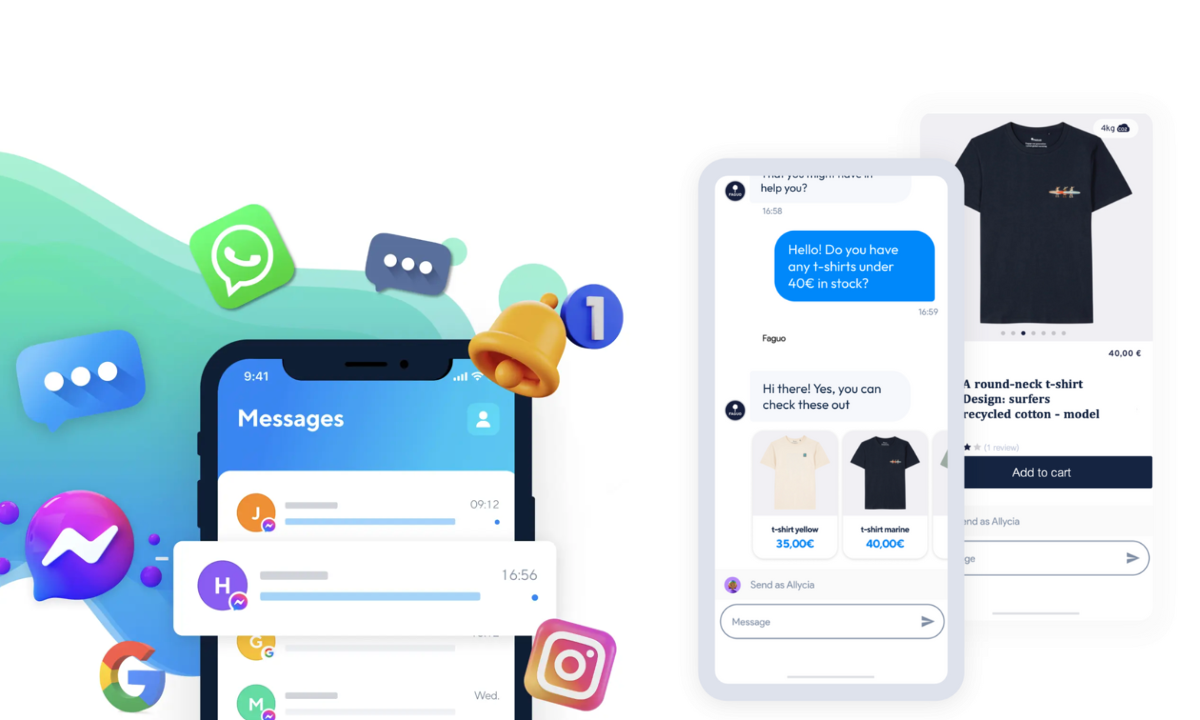
Table of contents
Artificial intelligence is set to revolutionise customer relations and experience – and more and more companies have realised that.
This is especially the case with the advent of generative AI, NLP technologies (Natural Language Processing), LLMs like ChatGPT, Claude, or Bard, and more recently, the arrival of GPTs, the new revolution announced by OpenAI in early November 2023. This article covers all of these topics without getting too technical, thereby initiating a certain reflection on the impacts of AI in the customer relationship – a reflection we’ve been conducting at Partoo for some time.
We will first examine how conversational commerce and instant messaging are gradually revolutionising the customer experience between brands and consumers. Then, we will explore how it’s possible to automate some or all of customer interactions through generative AI tools. Finally, we will explain how “GPTs” are removing one of the barriers to implementing conversational agents by businesses.
Omnichannel customer relations can be broken down into three major components: physical customer relations (1), telephone customer relations (2), and digital customer relations (3).
Over the past 20 years, customer relations have become increasingly focused on the digital realm, particularly with the surge in website traffic, the use of social media, and the extensive use of emails. Every sector has witnessed the emergence of digital “pure-players.” Online banks have competed with traditional banks, Amazon has disrupted traditional retail players, restaurants have explored the world of “dark kitchens,” and even the retail industry has had to contend with the influx of Quick Commerce startups like Gorillas, Flink, or Getir.
However, it is clear that physical customer relations still have a bright future. “Brick-and-mortar” businesses have shown resilience and quickly developed their digital expertise. Examples of this can be seen in the successful transformations of Decathlon, Carrefour, or Fnac. Conversely, many “pure players” are now opening physical retail locations (such as Nespresso, DGNBs, Le Slip Français, Asphalte, and more).
While many agree on the complementarity between physical and digital customer relations, the telephone system remains a challenging aspect of customer relations today. It’s a cost center that needs to be managed effectively.
Nevertheless, many consumers still prefer to call companies: they value their responsiveness on this channel (compared to email). This preference persists despite the sometimes excruciating wait times and high rate of unanswered calls, which can reach 50% in certain sectors like automotive or real estate. Whatever one may say, the volume of calls remains staggering: as a matter of fact, each year, Leclerc’s network of stores receives 20 million phone calls to their locations. At Orange, this number exceeds a hundred million! The question today is how digital solutions can help mitigate the costs associated with this channel.
To address this question, it may be helpful to take a step back. It’s likely that customer relations are following a similar trend as interpersonal relationships.
In our personal lives, we have completely transformed how we communicate with our loved ones. A hundred years ago, we primarily communicated when we met in person; then, the advent of the telephone revolutionised human relationships, but for the past decade, we have been making fewer phone calls – we exchange written messages instead. And we’re not just sending emails; we’re using texts, WhatsApp, Facebook messages, and more. As a result, 80% of our interactions with our loved ones occur through instant messaging. The same trend can be observed in our professional lives: Slack and Teams have redefined how employees collaborate. We used to work in the same office or call each other; today, we send 100 times more instant messages than emails. This is a significant underlying trend; for example, at Partoo, employees exchange over 20,000 Slack messages per day.
This immediacy has replaced the need for telephone calls, and this trend is reshaping how brands interact with their customers: in fact, we talk about “conversational commerce.” It involves conducting “commerce” through instant messaging, whether on their website, via SMS, or through the messaging platforms of certain platforms like Facebook, Snap, Instagram, WhatsApp, Google Maps, and more.
At Partoo we have been working for 3 years on our product “Messages“, which centralises and simplifies the management of messages from all online platforms.
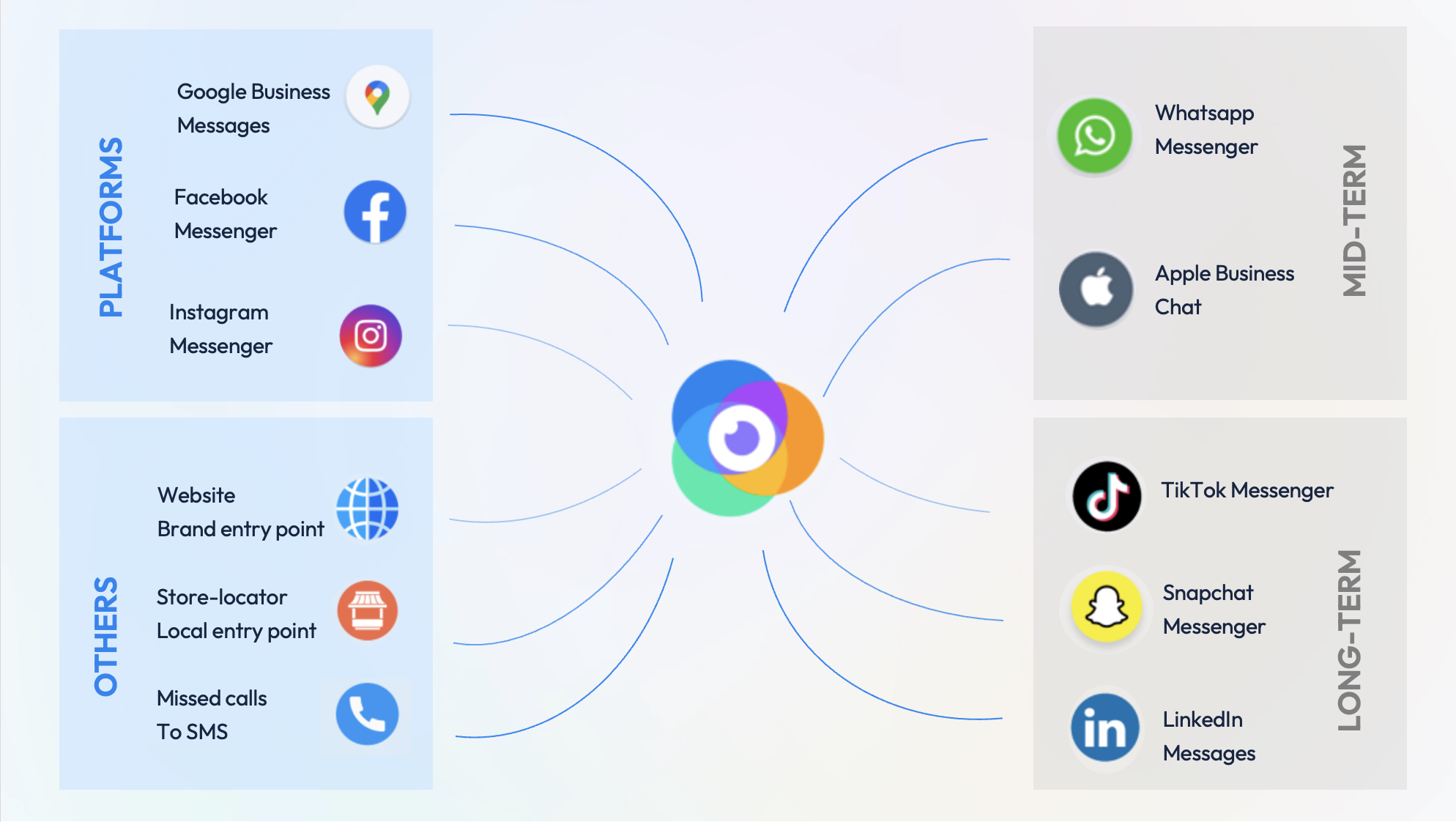
For businesses, there are two main advantages:
And on this subject, one statistic speaks volumes: 90% of consumers prefer to interact with a company through messaging rather than by phone. Indeed, beyond the immediacy, the experience is much more pleasant than over the phone: no more waiting music and interactive voice response (IVR) systems where you have to navigate through four options before being redirected to an online form.
Do you have doubts? It’s probably related to your disappointing experience with chatbots from the 2000s. Buttons to click, no real-time responses, an inability to be contacted without leaving your email or phone number.
It is useful to note here that ChatGPT has completely changed the game, and I believe that new AI technologies are paving the way for a revival of chatbots. Similar to what happened with QR codes in 2022, I am convinced that chatbots will rise from their ashes – probably under a new name to help forget their less-than-glorious past.
It’s worth noting that “conversational commerce” can also be a solution to unanswered calls at physical store locations. In practice, when a customer calls a store, they don’t get an answer half the time. An IVR system can then prompt them to press 1 if they agree to continue the conversation via SMS (this functionality has been developed by Partoo under the name “call-deflector”). They can then engage with the store manager via asynchronous SMS messaging: the local manager has access to a single Partoo application where messages from these missed calls, the website, and all instant messaging platforms like Google Maps, Facebook, Instagram, or WhatsApp are centralised.

There are a number of ways to increase efficiency and automate all or part of your customer communications.
The first step is to establish response templates based on recurring questions to be addressed. This will primarily save time for human agents responsible for replying to user messages – it is, in fact, what we have implemented at Partoo for our clients. Another way to address the same use case is to work on AI-driven response suggestions: the human agent handling the incoming message receives a suggested response and can either validate it or edit it.
However, this is more of an aid to processing rather than full automation. To automate the processing of incoming messages, there are three other methods:
At Partoo, we initially approached the topic of automation through a feature we called “Conversation Starter“. The idea is to offer users several topic choices, such as “track my order,” “schedule an appointment,” or “view the menu.” When the customer clicks on the button, a pre-drafted answer is provided to detail the menu or redirect them to an appointment scheduling interface. If the customer doesn’t find the answer to their question, a human agent then takes over, technically referred to as a “hand-over.”
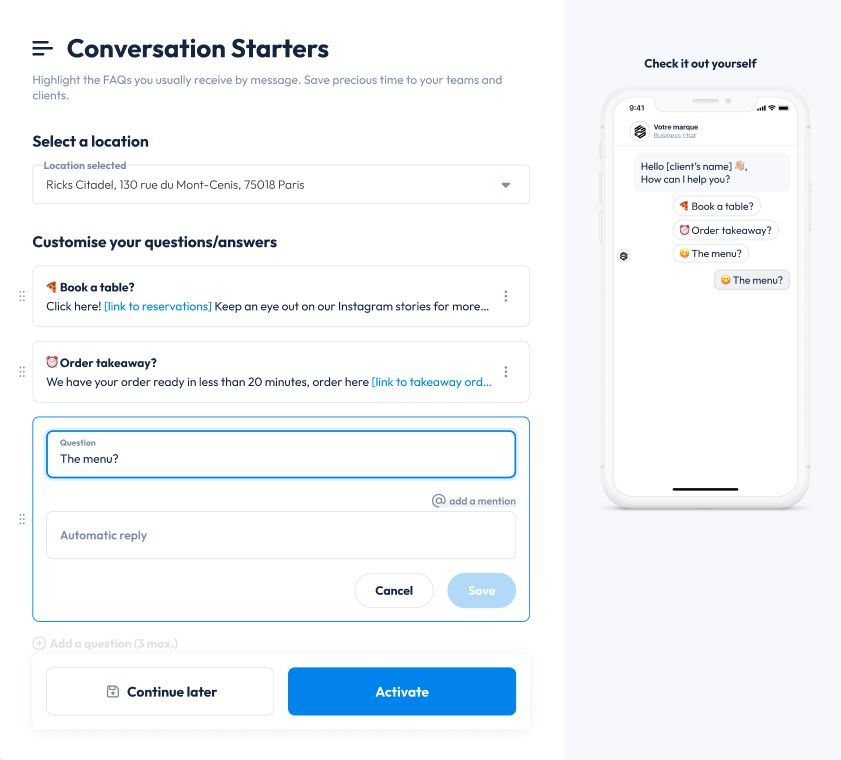
However, this is only level 1 of a decision tree: the customer could click on “buy a product”, then “socks”, then “size 43” and so on. Each choice then moves them forward in a decision tree, enabling the chatbot to answer their question more precisely.
AI algorithms existed well before generative AI, and they were primarily used for tasks such as text extraction and intent recognition. By providing a chatbot with a set of questions and responses, AI algorithms from the 2010s could already recognize the subject of a posed question and select pre-drafted responses to address certain inquiries.
For example, if a user wants to know if there is parking available, and the business has inputted the question “Do you have parking?” and the answer “Yes,” a customer asking, “I’m coming by car, do you have parking?” would receive the response “Yes.” However, it’s evident that information extraction algorithms have significant limitations because they recognize simple intentions but cannot provide genuine intelligence in their replies.
Artificial intelligence is typically divided into three branches of applications: Computer Vision technology (images and videos), robotics, and Natural Language Processing (NLP). It’s this third branch of application that has seen the most significant advancements this year with the emergence of tools like ChatGPT.
ChatGPT is a Large Language Model (LLM), which means it’s an artificial intelligence algorithm capable of understanding the intent of a complex question, searching for the requested information, and providing a novel and comprehensible response. For customer relations, it represents a true revolution!
Let’s take an example of a database containing the following information: “We have a parking lot located to the left of the church when you exit the highway, with 150 spaces. It’s usually open except on Tuesdays and Sundays. In that case, you can park at the highway exit.” If a user were to ask the question “I’m comin by car, how do I park?” (even with a spelling mistake), the AI would answer, “There is a parking lot next to the church, but it can be full at times. What day are you planning to come?”
The real question that arises now is not about the intelligence level (which is already at the right level to handle these requests) but about information: how to provide artificial intelligences with the right information so that they can meet the needs of users?
A Large Language Model (LLM) is a generative intelligence that has been pre-trained on a large corpus of text; in the case of ChatGPT, it’s the internet up to a fixed date.
Updating the data of an LLM involves retraining it, which can be extremely costly. Historically, it has been challenging to “feed” a company-specific AI with continuously updated data because it would require continuously retraining the LLM, which is expensive and time-consuming. One solution exists: data extraction based on a specific question, and integrating this data, including the response, into the prompt sent to the LLM.
To wrap up technical matters, the good news is that ChatGPT recently introduced a feature that allows continuous data feeding to an LLM, and even the connection with other databases. This opens up possibilities in what we are developing at Partoo, specifically, instant messaging management tools!
To “feed” an artificial intelligence specialised in handling user inquiries, it is essential to consider various data sources.
The first source we consider at Partoo is the point-of-sale database: we manage this data for nearly 1,000 client brands worldwide (Leroy Merlin, Toyota, LCL, etc.). Through our “Presence Management” technology, we store and disseminate information about nearly 300,000 points of sale on the internet, particularly on platforms like Google Maps. This includes their opening hours, addresses, phone numbers, menus, services, photos, booking links, and more. We also have the ability to add additional fields to our database to store other data that may be useful for our clients, such as the presence of a parking lot in the example mentioned earlier.
By providing this database to an AI specifically trained for a client, we can answer questions like “What time do you open next Sunday?” or “Do you offer oil changes at your dealership?” However, raw data alone may not suffice to feed an AI for all types of questions. It may be necessary to create a specific knowledge base in textual or other formats, and that’s an area we are currently exploring.
After connecting the conversational agent to our Partoo database and a specific knowledge base, it can be beneficial to connect to other databases available within our clients’ ecosystems. Each database is typically associated with a tool and an acronym, such as CRM (Customer Relationship Management), OMS (Order Management System), ERP (Enterprise Resource Planning), PIM (Product Information Management), and so on.
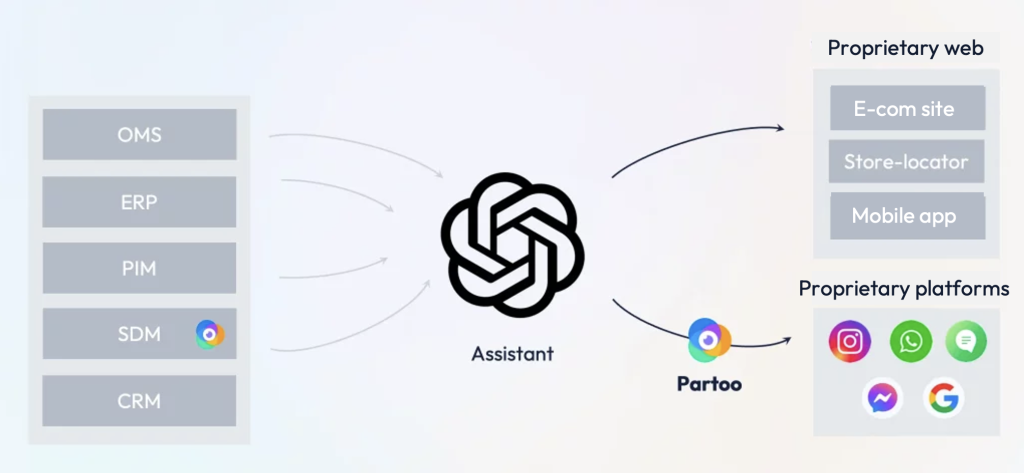
Let’s consider some use cases to be more specific.
By connecting a Product Information Management (PIM) system coupled with point-of-sale stock data, it’s possible to address various product-related questions: Do you have Tropicana fruit juice in stock? What is the price of 1L of Andros fruit juice? Are there any promotions on these products? What is their nutri-score?
We could even envision advising customers in their product choices! An AI-boosted conversational agent could answer questions like, “I want to run a marathon in 6 months, what pair of shoes do you recommend?” It could further refine the request through a messaging exchange to better understand the customer’s needs and guide them to the right product, even facilitating the sale through e-commerce or click-and-collect!
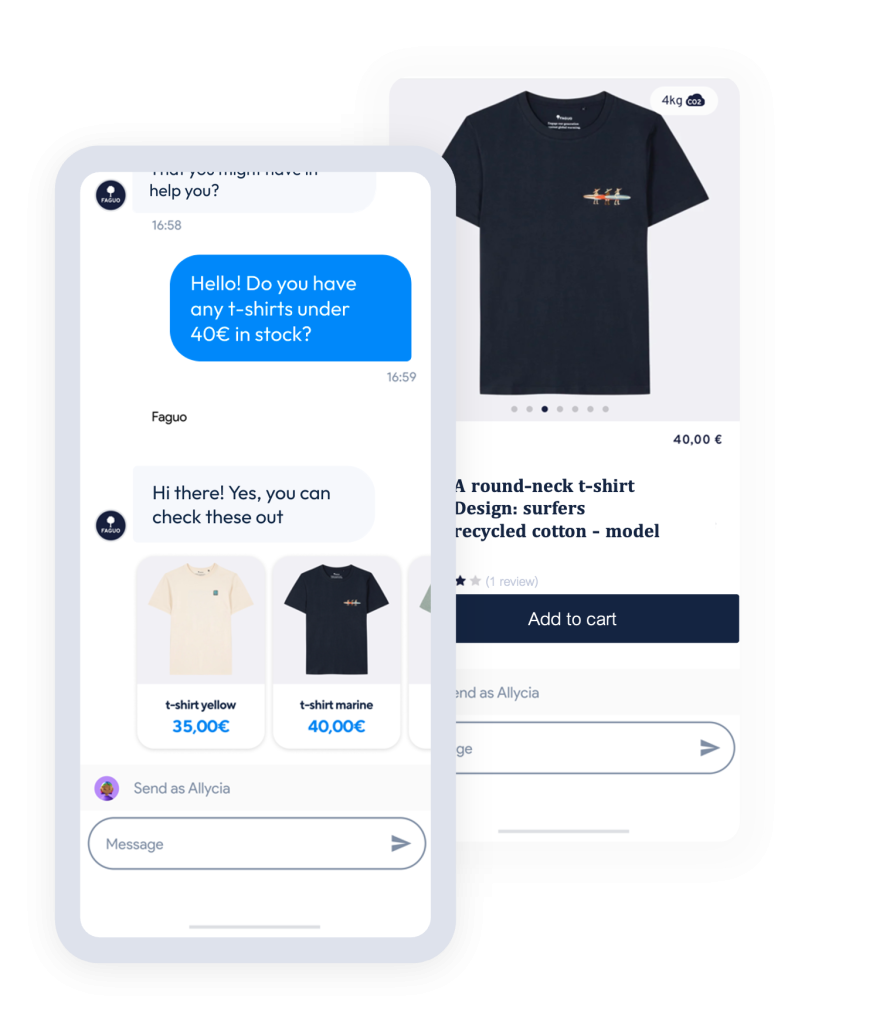
And to track orders once a pair of shoes has been chosen, nothing could be simpler: all the retailer has to do is connect its OMS (Order Management System). Customers could then provide their access codes to find out the status of their parcel.
* * * * *
The potential of AI in relation to customer relations is infinite; it can be a source of concern or excitement. One thing is certain: businesses must prepare for it. At Partoo, we believe that the customer relations of tomorrow will be conversational, and for companies to make this shift, they must focus on three aspects:
If you want to delve deeper into this topic, feel free to look into Google SGE (Search Generative Experience). Among the beliefs we hold at Partoo, one of them is that beyond the customer experience, the entire internet is becoming conversational today.
Want to easily develop your business through the Internet? It’s possible thanks to Partoo!
Receive our best articles and practical guides directly in your inbox every month